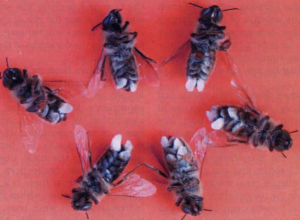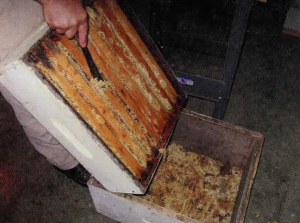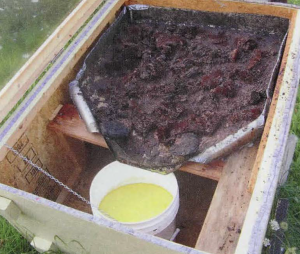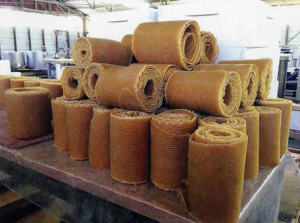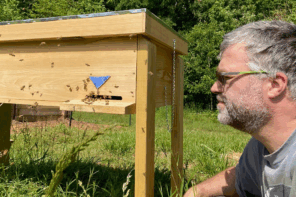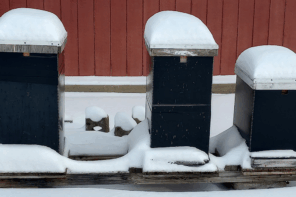By: Ross Conrad
This article originally appeared in the Winter 2016 issue of BEEKeeping Your First Three Years
A colony of honey bees tends to be evaluated by the number and condition of the bees it contains. This narrow focus overlooks an extremely important component of a healthy hive: the beeswax comb. The combs in a hive can act as the skeleton, furniture, nursery, food pantry, and communication infrastructure of the colony, all at the same time. For beekeepers, honey bee comb is a source of valuable beeswax. Other types of bees produce wax that is very different from the wax produced by honey bees, of the species Apis. For example, certain species of stingless bees are reported to produce a wax that is more difficult to break and stickier than beeswax from Apis mellifera. Wax from stingless bees also tends to be dark brown and stretches without breaking when warmed.
The geometric shape of the cells found in beeswax comb result in the incredibly efficient engineering of the comb. The hexagon cross-section of each cell makes use of the least amount of material in order to create a lattice within a given volume. Hungarian mathematician, Laszlo Fejes Toth, discovered that the shape used by the honey bee to build cells is not, theoretically, the most efficient shape possible. Toth discovered a shape that would be .035% more efficient. However, this difference is too small to be measured on actual comb, and irrelevant to the colony’s efficient use of wax given that natural comb varies considerably from the mathematical notion of perfect geometry. For all practical purposes, the shape of the cells that the honey bee uses allows a colony to store the most honey using the least amount of wax.
Production
Honey bees build their comb from small wax flakes, or scales, that they produce from the four pairs of wax glands on the underside of their abdomen. Wax secretion is stimulated by the retention of carbohydrates within the systems of the younger honey bees. The wax is secreted in liquid form on the ventral surface of the abdominal tergites (plates on the underside of the bee’s abdomen). As the liquid wax spreads over the surface of these plates, the wax hardens as it cools through contact with the air and forms a scale. Honey bees can produce up to eight scales of wax every 12 hours when necessary. A worker bee’s wax glands seem to function best when the bee is 10-18 days old and they decline after the bee is older than 18 days, usually shrinking steadily until
the end of her life. However, after swarming wax production and building is undertaken by bees of all ages with young bees producing wax earlier than they would in an established colony, and older bees regressing to resume beeswax production. Bees use stiff hairs on their hind legs to pass the scales to the middle legs, and then to the mandibles (jaws) where the wax is chewed during which saliva and enzymes are mixed with the wax. When it is the right consistency, the wax is used to construct comb and seal cells filled with honey.
This is nature’s way of providing for the bee’s needs. As long as a worker bee has access to empty comb to store excess nectar or honey that is not immediately needed for dietary requirements its wax glands are not activated. However, when there is no place to store excess carbohydrate resources within the hive and the carbohydrates are held within the body of the bees without being digested, the bees will expend the biological energy to produce beeswax. This wax becomes the building material used to construct additional comb that will provide added storage space for the excess nectar and/or honey. Research has found that bees need to consume 6.6 – 8.8 pounds of honey for every pound of beeswax they produce. Wax producers also need to have previously eaten large amounts of pollen in order to have well-developed wax glands.
Workers mold the wax scales with their mandibles into circular cells while the temperature within the colony is maintained high enough that the wax is in a semi-liquid state during construction. Just as two bubbles that come together will form a perfectly straight side between them, the sides of the circular beeswax cells will flatten out against each other in the warmth of the clustering bees, resulting in the familiar hexagonal shaped cells that make up honey comb. In order to help prevent the nectar and honey that will be stored from spilling out of the cells, each cell is tilted slightly upward at an angle of approximately 10 degrees.
A pound of beeswax when formed into comb can hold about 22 pounds of honey. However, the top row of cells connecting the comb with the roof of the hive, tree cavity, or top bar, can hold more than 1,300 times its weight in honey, bees, brood, pollen and wax. It is only when the temperature inside the hive increases to over 95° F (35° C) that the wax will soften and can eventually melt, causing the comb to collapse. As a result, the bees make a great effort to regulate the temperature inside the hive. The incredible load that beeswax combs are asked to carry highlight the importance of making foundation from beeswax that is unadulterated, since foundation wax made from beeswax that has been mixed with other waxes or oils can cause problems for the bees ·and the beekeepers.
Design Considerations
L. L. Langstroth is most often credited with bringing the idea of bee space into modern beekeeping. When allowed to build combs naturally, a colony of honey bees will leave a bee space of about 5/16th of an inch between the combs. This space assists the hive in manipulating the temperature within the hive, aids with ventilation and acts as a hallway for the passage of bees traveling across the combs.
Rudolph Steiner, the founder of Biodynamics, has noted that each cell that makes up a honey bee comb takes on the shape of a hollowed out, or inverted crystal. When filled with nectar, honey or pollen, the food is stored in the shape of a crystal. This is also the shape that surrounds each bee egg as it hatches and transforms into a larvae, and finally a mature honey bee. Given the unique and powerful forces that crystals emit, it seems likely that honey bees are making use of these energies within the hive in ways that we are only able to vaguely guess at. When bees build comb, they create a slight bulge in the rim around the opening of each cell. This bulge forms a net of six-sided mesh over the surface of the comb and plays an important role in the complex interaction between the physical properties of the beeswax, and the bee’s communication behavior. When foragers return to the hive and perform the waggle dance, they send out vibrations along the rim of the comb during each waggle run that help communicate to and recruit additional foragers in the darkness of the hive where optical signals are ineffective.
Much has been made by some as to the importance of the cell orientation within a colony. This has become known as Housel positioning, named after one of its proponents, Michael Housel, of Orlando, FL. The basic idea is that the “Y” that is formed in the base of each cell has a certain orientation that occurs when bees build their comb naturally. For bees to be healthier and more productive, it is theorized this Housel positioning should be copied when beekeepers use foundation within the hive. The idea that there is a right way and a wrong way to install foundation within the frame would be valuable information if it were true. Unfortunately, studies of the cell orientation within hives filled with combs built naturally without foundation (Roger Morse, 1983 and Shumakova & Komissar, 2006) does not support this hypothesis. Bees seem to orient the cells of the comb based upon the first cell built within the comb. Cell orientation will tend to be uniform within each comb, but may differ on adjacent combs.
The Nature of Beeswax
Since beeswax is a product of the body of the honey bee, it tends to have very similar characteristics no matter where in the world the beeswax is produced. Recent research has highlighted the absorbent nature of combs built from beeswax. Among other things, disease organisms and residues from chemical pesticides that are lipophilic (oil based) and therefore soluble in beeswax have been shown to build up in comb over time. This has resulted in the recommendation that combs be rotated out and replaced on a regular basis. When using synthetic chemical mite controls or antibiotics in the hive, it is recommended that combs be replaced every couple of years. It is possible that if more natural treatments such as essential oils, organic acids, and herbs are utilized, rotation times may be able to be extended without seeing detrimental results on the colony’s state of health. Since many of the non-synthetic/non-drug treatments are relatively new, long-term impacts on comb is mostly unknown at this time.
Beeswax is incredibly stable over time. Samples of wax from Egyptian tombs, the ruins of Rome, and Viking ships found at the bottom of the sea, have all been perfectly fine and undamaged. When chilled beeswax becomes brittle however, it may crack or break easily. This is why most suppliers of beeswax foundation will only ship orders when temperatures are relatively warm. The melting point of beeswax is around 145° F (63° C).
Beeswax will accumulate a whitish, frosted coating on its surface. This coating, known as “bloom”, is a natural part of the wax that migrates to the surface. The appearance of bloom on items made of beeswax signifies that the items are made with 100% pure beeswax. Beeswax that has been diluted with other types of wax will not bloom. Rubbing the surface of the wax with a clean cloth will remove bloom from candles or other items. For items that are too delicate or ornate to clean with a cloth, warm water poured over it, or a blast of warm (not hot) air from a blow dryer will remove the bloom. A block of pure beeswax will have a pleasant aroma and when broken exposes a grainy surface inside. This is not the case if the wax has been adulterated with paraffin, fat or other oil.
Wax Harvesting and Processing
For most beekeepers, beeswax production is a by-product of honey production. When honey is being extracted from the comb, the wax cappings are removed with an uncapping knife or machine. Wax derived from cappings is considered to be of the highest quality. This is because cappings wax will tend to be fresh wax that is less than a year old, containing a minimum of impurities making it very light in color. Wax collected from burr comb, hive scrapings, and old or broken combs will tend to be darker due to the increased presence of pollen, propolis, pupae cocoons, wax moth excrement, or other debris. Once it is melted down, beeswax should be clarified by mixing it with water to remove water soluble impurities such as honey, and then filtered. Small operations may use homemade filters such as sweatshirt material, fuzzy side up. Larger operations will often use steam along with a press of some kind for best results.
Slumgum is the term used to describe the residues left over from the process of rendering wax. Heating beeswax above 185° F (85° C) may cause discoloration. Oxalic acid or sunlight are among the things that can be used to lighten the color of beeswax through bleaching. Certain metals such as iron, brass, zinc, and copper should be avoided during the rendering process, as beeswax will darken when heated in the presence of these metals.
Uses
In 1911, researchers uncovered a human jawbone in a cave in Slovenia that contained a lump of beeswax. Scientists theorize that the beeswax may have been an attempt to treat a broken tooth. Not much of a fix, but probably the best they could come up with in the Neolithic era.
Apart from the bee’s use of wax to produce comb and beekeeper’s use of beeswax to manufacture comb foundation, the number and variety of uses humans have developed for beeswax in recent history is rather astounding. Uses include cosmetics and skin care, pharmaceuticals, candles, waterproofing, food production and chewing gum, surgery, polishes, various types of sculpting and art, as well as the manufacture of musical instruments, ammunition and armaments. Beeswax is an excellent lubricant and is useful for seasoning and curing cast-iron cookware, strengthening and preserving sewing thread, and in bow making.
Beeswax is a unique and extremely valuable product that is worth more pound for pound than honey. Not being a food product, beeswax is simpler to deal with, as it does not require special packaging or storage. Unfortunately, many beekeepers do not recognize the value of beeswax and knowledge of how to collect and process it is often lacking as well. While it is impossible to give statistics, it has been estimated that only about half of the world’s production of beeswax makes it to market, while the rest is thrown away, ignored or lost.








